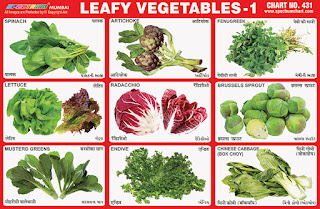Spinach - Spinach is a
green leafy vegetable. Spinach has many health promotional and
disease prevention properties. Spinach leaves are an excellent
source of vitamin K. Its also contain a good amount of minerals like
potassium, manganese, magnesium, copper and zinc.
Artichoke - Artichoke
belongs to the group of thistles. Artichoke has deeply lobed,
silver, grey-green or bronze-green coloured leaves. It is a rich
source of dietary fibres, vitamins K, B9 and C and minerals such as
sodium, manganese and magnesium. Artichoke cannot be consumed raw.
Artichoke can be fried, grilled, baked or cooked and used for the
preparation of stews, soups, salads, sauces and casseroles.
Artichoke facilitates digestion and improves functions of liver and
gall bladder.
Fenugreek - Fenugreek is
used as an herb, spice and vegetable in Indian sub-continent.
Fenugreek have bitter taste and strong smell. Fenugreek is
inevitable part of Indian cuisine. Fenugreek is rich source of
dietary fibres, proteins, vitamin B6 and minerals such as iron,
manganese, magnesium and copper. It helps to reduce high blood
cholesterol level, improve digestion and relieve symptoms of anaemia,
fever, mouth ulcers, respiratory disorders, diabetes, insomnia and
inflammation.
Lettuce - Lettuce is leafy
vegetable that belongs to the sunflower family. Lettuce provides
dietary fibres, vitamins A, B9 and C and minerals such as calcium,
iron and copper. Darker varieties provide more nutrients than light
green varieties. Lettuce can be consumed in the form of salads or as
an ingredient of sandwiches. It can be also used for the wrapping of
food.
Radicchio - Radicchio
belongs to the aster family. Radicchio is rich source of dietary
fibres, vitamins K, C and A, and vitamins of the B group and
minerals such as manganese, copper, selenium and iron. Leaves of
radicchio are succulent, crunchy and have more or less bitter &
spicy taste. They can be consumed fresh in the form of salad or
cooked, grilled or roasted.
Brussels Sprout - Brussels
sprout is a member of the Gemmifera Group of cabbages. They are
typically 2.5 – 4 cm in diameter. Brussels sprouts contain
excellent levels of vitamin C and vitamin K, with more moderate
amounts of B vitamins, such as folic acid and vitamin B6. Brussels
sprouts buds are typically cooked by boiling, steaming, stir frying,
grilling or roasting.
Mustard Greens - Mustard
greens are the leaves of the mustard plant. Most mustard greens are
actually emerald green in colour. Mustard greens are a rich source
of vitamins A, C and K.
Endive - Endive is leafy
vegetable and cool-season crop that belongs to the aster family.
Endive is used for the preparation of salads, soups, stir-fries,
curry or it can be cooked and consumed like spinach. Endive can
prevent cataract, anaemia and development of certain types of cancer.
It also aids digestion and improves function of liver and
gallbladder.
Chinese Cabbage (Bok Choy)
- Chinese cabbage, is leafy vegetable that belongs to the mustard
family. It originates from East Asia. Chinese cabbage develops
roundish, spoon-shaped, glossy, dark green leaves. Unlike the true
cabbage, Chinese cabbage does not have leafy head. It is
rich source of dietary fibres, vitamins A, K, C and vitamins of the
B group and minerals such as calcium, phosphorus and potassium.


No comments:
Post a Comment